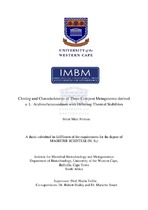| dc.description.abstract | Second generation biofuels production requires a suite of lignocellulolytic enzymes, acting synergistically to liberate the fermentable monosaccharides contained within agricultural waste materials. The use of thermostable lignocellulosic enzymes in a high-temperature process represents a number of advantages over their respective mesophilic counterparts, including increased solubility of the polymeric lignocellulosic substrates, enhanced enzyme processivity and reduced risk of bacterial and/or phage contamination during fermentation (Turner et al., 2007; Viikari et al., 2007). Alpha-L-arabinofuranosidases (AFases) participate in the deconstruction of lignocellulosic materials by hydrolysing the arabinofuranosyl bonds contained within the hemicellulosic portion of lignocellulose. In this study, three AFases isolated from compost-derived metagenomic DNA were characterised. Three genes derived from the fosmid metagenomic library constructed from 70°C compost were cloned into the pET21a(+) expression vector and expressed in E. coli BL21. The heterologously expressed proteins, AFase_H4, AFase_E3 and AFase_D3, were subsequently purified and their biochemical characteristics determined. All three AFases were shown to be active between pH 4.0 and 6.0. AFase_H4 and AFase_E3 displayed the highest activity at 60oC, while AFase_D3 had an optimum temperature at 25oC. Furthermore, the three AFases had differing thermostability profiles. In particular, AFase_E3 maintains 100% residual activity following 60 min incubation at 80oC and 24 hour incubation at 60oC. All three AFases have activity upon p-Nitrophenyl-arabinofuranoside and none against a range of alternative p-Nitrophenylglycosidic substrates. Phylogenetic analysis of the catalytic domain, identified within the amino acid sequences of the AFases, suggests that these AFases belong to glycoside hydrolase (GH) family 51. The difference in the AFase primary amino acid sequence motifs were used to infer differences in thermostability. All three AFases indicated similar biochemical and biophysical characteristics. AFase_E3 was determined to be the most thermostable amongst all three AFases. In the assessment of the three AFases respective suitability for inclusion in thermogenic bioethanol production processes, AFase_E3 was concluded as a suitable candidate for hydrolysis and synergistic testing on natural substrates. AFase_D3 possess the potential to be included in novel mesophilic industrialized process. | en_US |

